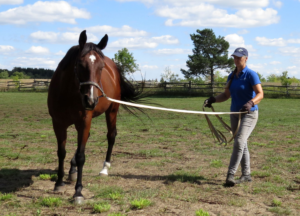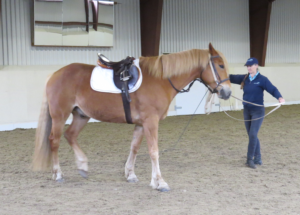If lunging your horse has ever left you feeling frustrated, nervous - or even a little scared - you’re not alone. Many riders give up on it completely because their horse bolts, bucks, turns in to face them, or simply won’t go forward.
More Than Just “Getting the Bucks Out”
But, lunging is about so much more than just "getting the bucks out" or dealing with a fresh horse. When done well, it can be a valuable training tool that:
- tells you how your horse is feeling,
- builds fitness,
- improves posture,
- deepens your connection
...while calming the nervous system - for both you and your horse.
When you think of lunging as a way to help your horse relax, tune in, and move in better balance - not just physically, but mentally and emotionally as well - it changes how you respond.
Unfortunately, many people feel frustrated, overwhelmed, or even a little bit scared while trying to lunge their horse.
“My Horse Won’t Lunge!” – You’re Not the Only One
One woman at a recent clinic told me she had completely given up lunging her horse because he was so difficult to control.
Others worry about getting hurt, injuring their horse, or even making their horse more anxious - especially when their horse bucks, bolts, or spins to face them instead of going forward.
And then there are riders like Emma, who sent me this message:
"I have a young Gelding who was broken in without any lunging experience. When it come to introducing this to him it seems like we are working backwards. I am really struggling to teach him to understand what i am asking of him.
We get a couple of good circles which always follows with him turning to face me.
Would really appreciate some advice on how to improve this in the correct way. Any assistance would be greatly appreciated.
Regards Emma"
If you’ve ever thought “my horse won’t lunge”, know that lunging can be a helpful, safe and positive experience - for both you and your horse.
“My Horse Won’t Lunge” – What’s Really Going On?
It’s one of the most common things I hear from riders. And it usually shows up in one of these ways:
- The horse won’t go forward
- The horse turns in and faces the handler
- The horse bucks, rears, or bolts
- The horse races around counter-bent and unbalanced
These behaviours aren’t signs of a badly behaved horse - or a bad handler.
They’re signs of confusion, stress, or miscommunication.
The good news? With a few small changes in your posture and intention, you can clear up the confusion and lunge in a way that feels safer, calmer, and more productive.
Why Your Body Position Matters So Much
Horses notice everything. Your shoulders, hips, feet, and even your breathing send signals—whether you realise it or not.
Many of us were taught to stand in a triangle shape when lunging, with our body pointing directly at the horse. But for many horses, especially the sensitive or reactive ones, that posture can feel threatening, blocking, or confrontational
The result? They turn in, refuse to go forward, or try to escape the energy coming at them.
The good news? With a few simple shifts in your body language and alignment, you can start to feel more confident - and so can your horse.
A Simple Trick to Get the Feel
Here’s an easy way to get a feel for the right alignment. Imagine pushing a wheelbarrow in a circle. To guide it smoothly, your body naturally curves into the arc.
The same idea works when lunging your horse:
Aim your belly button at the horse’s shoulder
Keep your inside shoulder slightly back, creating an open arc
Angle your outside hip toward your horse’s hip
Step toward the girth with your inside foot, and toward the flank with your outside foot
This gentle posture gives your horse clarity - without confrontation. It’s body language they understand.
The #1 Fix Most Riders Don’t Know About
Your posture and energy are powerful. Horses notice everything - your shoulders, hips, feet, focus, and breath. Traditional lunging often sends mixed signals, especially to sensitive or reactive horses.

Communicate With Energy, Not Force
Once your posture is lined up, your energy does the talking.
To ask for forward, you can use a light push from your core, arm, or hip. If your horse needs a bit more encouragement, gently swing the end of your lunge line (or lunge whip, if you use one) upward toward the flank area - where one horse would push another to say, “Move along.”
There’s no need to snap the whip or hit your horse. Just send gentle energy. Even increasing the speed (RPMs) can create a more energetic ask without feeling aggressive.
Quick Fixes for Common Lunging Issues
These quick shifts in your posture and energy can help smooth out common problems:
Horse pulls out of the circle? Gently push their hips out to bring the front end back in.
Horse turns in to face you? Step in to block or push their shoulders out.
Horse rushes or feels unbalanced? Soften your steps, slow your breath, and bring your energy down.
You don’t have to get it perfect. Small adjustments often make a big difference.
Calm Creates Confidence For Both Of You
When you’re aligned in your body, your horse feels it - and responds. You don’t need to be forceful. You don’t need to “dominate” them. You just need to communicate in a way they understand.
That’s where your confidence grows - because your horse starts to feel more relaxed, cooperative, and connected. And so do you.
Lunging doesn't need to be a battle that stressed out you and your horse! It can be a calming exercise that deepens confidence, connection, and communication.
Making it a positive experience for both of you.
🎥 Click here to watch my video where I demonstrate the correct posture and alignment for calm, effective lunging.
Looking for More Calm, Confidence, and Connection?
If you’re ready to feel safer and more in control - on the ground and in the saddle - here are your next steps:
💙 Download my free guide: 10 Anti-Anxiety Techniques for Horse Riders
💙 Join our Facebook group: The Horse Riding Confidence Community
💙 Visit
confidenthorsemanship.com
to explore coaching and courses
Ride more, worry less, and enjoy every ride.


